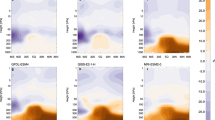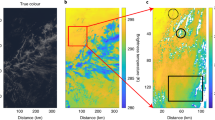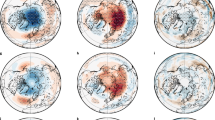Abstract
Radiative forcing from anthropogenic ozone in the troposphere is an important factor in climate change1, with an average value of 0.35 W m−2 according to the Intergovernmental Panel for Climate Change1 (IPCC). IPCC model results range from 0.25 to 0.65 W m−2, owing to uncertainties in the estimates of pre-industrial concentrations of tropospheric ozone1,2,3, and in the present spatial and temporal distributions of tropospheric ozone4,5,6,7,8, which are much more variable than those of longer-lived greenhouse gases such as carbon dioxide. Here, we analyse spectrally resolved measurements of infrared radiance from the Tropospheric Emission Spectrometer9 on board the NASA Aura satellite, as well as corresponding estimates of atmospheric ozone and water vapour, to obtain the reduction in clear-sky outgoing long-wave radiation due to ozone in the upper troposphere over the oceans. Accounting for sea surface temperature, we calculate an average reduction in clear-sky outgoing long-wave radiation for the year 2006 of 0.48±0.14 W m−2 between 45∘ S and 45∘ N. This estimate of the clear-sky greenhouse effect from tropospheric ozone provides a critical observational constraint for ozone radiative forcing used in climate model predictions.
This is a preview of subscription content, access via your institution
Access options
Subscribe to this journal
Receive 12 print issues and online access
$259.00 per year
only $21.58 per issue
Buy this article
- Purchase on Springer Link
- Instant access to full article PDF
Prices may be subject to local taxes which are calculated during checkout



Similar content being viewed by others
References
Forster, P. et al. in The Fourth Assessment Report of the Intergovernmental Panel on Climate Change (ed. Soloman, S. et al.) (Cambridge Univ. Press, Cambridge, 2007).
Gauss, M. et al. Radiative forcing since preindustrial times due to ozone change in the troposphere and the lower stratosphere. Atmos. Chem. Phys. 6, 575–599 (2006).
Mickley, L. J., Jacob, D. J. & Rind, D. Uncertainty in preindustrial abundance of tropospheric ozone: Implications for radiative forcing calculations. J. Geophys. Res. Atmos. 106, 3389–3399 (2001).
Gauss, M. et al. Radiative forcing in the 21st century due to ozone changes in the troposphere and the lower stratosphere. J. Geophys. Res. Atmos. 108, 4292–4313 (2003).
Kiehl, J. T. et al. Climate forcing due to tropospheric and stratospheric ozone. J. Geophys. Res. Atmos. 104, 31239–31254 (1999).
Naik, N. et al. Net radiative forcing due to changes in regional emissions of tropospheric ozone precursors. J. Geophys. Res. Atmos. 110, D24306 (2005).
Portmann, R. W. et al. Radiative forcing of the Earth’s climate system due to tropical tropospheric ozone production. J. Geophys. Res. Atmos. 102, 9409–9417 (1997).
Stevenson, D. S. et al. Multimodel ensemble simulations of present-day and near-future tropospheric ozone. J. Geophys. Res. Atmos. 111, D08301 (2006).
Beer, R. TES on the Aura mission: Scientific objectives, measurements, and analysis overview. IEEE Trans. Geosci. Remote Sens. 44, 1102–1105 (2006).
Schoeberl, M. R. et al. Overview of the EOS Aura mission. IEEE Trans. Geosci. Remote Sens. 44, 1066–1074 (2006).
Clough, S. A. et al. Forward model and Jacobians for tropospheric emission spectrometer retrievals. IEEE Trans. Geosci. Remote Sens. 44, 1308–1323 (2006).
Clough, S. A. & Iacono, M. J. Line-by-line calculation of atmospheric fluxes and cooling rates 2. Application to carbon dioxide, ozone, methane, nitrous oxide and the halocarbons. J. Geophys. Res. Atmos. 100, 16519–16535 (1995).
Bowman, K. W. et al. Tropospheric emission spectrometer: Retrieval method and error analysis. IEEE Trans. Geosci. Remote Sens. 44, 1297–1307 (2006).
Kulawik, S. S. et al. Implementation of cloud retrievals for Tropospheric Emission Spectrometer (TES) atmospheric retrievals: Part 1. J. Geophys. Res. Atmos. 111, D24204 (2006).
Worden, H. M. et al. TES level 1 algorithms: Interferogram processing, geolocation, radiometric, and spectral calibration. IEEE Trans. Geosci. Remote Sens. 44, 1288–1296 (2006).
Worden, J. et al. Predicted errors of tropospheric emission spectrometer nadir retrievals from spectral window selection. J. Geophys. Res. Atmos. 109, D09308 (2004).
Shephard, M. W. et al. Tropospheric emission spectrometer spectral radiance comparisons. J. Geophys. Res. Atmos. (in the press).
Tobin, D. C. et al. Radiometric and spectral validation of atmospheric infrared sounder observations with the aircraft-based scanning high-resolution interferometer sounder. J. Geophys. Res. Atmos. 111, D09S02 (2006).
Nassar, R. et al. Validation of tropospheric emission spectrometer (TES) nadir ozone profiles using ozonesonde measurements. J. Geophys. Res. Atmos. (in the press).
Jourdain, L. et al. Tropospheric vertical distribution of tropical Atlantic ozone observed by TES during the northern African biomass burning season. Geophys. Res. Lett. 34, L04810 (2007).
Huang, X. L., Ramaswamy, V. & Schwarzkopf, M. D. Quantification of the source of errors in AM2 simulated tropical clear-sky outgoing longwave radiation. J. Geophys. Res. Atmos. 111, D14107 (2006).
Harries, J. E., Brindley, H. E., Sagoo, P. J. & Bantges, R. J. Increases in greenhouse forcing inferred from the outgoing longwave radiation spectra of the Earth in 1970 and 1997. Nature 410, 355–357 (2001).
Haskins, R. D., Goody, R. D. & Chen, L. A statistical method for testing a general circulation model with spectrally resolved radiances. J. Geophys. Res. Atmos. 102, 16563–16581 (1997).
Huang, X. L. & Yung, Y. L. Spatial and spectral variability of the outgoing thermal IR spectra from AIRS: A case study of July 2003. J. Geophys. Res. Atmos. 110, D12102 (2005).
Loeb, N. G. et al. Angular distribution models for top-of-atmosphere radiative flux estimation from the Clouds and the Earth’s Radiant Energy System instrument on the Terra Satellite. Part I: Methodology. J. Atmos. Oceanic Technol. 22, 338–351 (2005).
Oltmans, S. J. et al. Tropospheric ozone over the North Pacific from ozonesonde observations. J. Geophys. Res. Atmos. 109, D15S01 (2004).
Fishman, J., Watson, C. E., Larsen, J. C. & Logan, J. A. Distribution of tropospheric ozone determined from satellite data. J. Geophys. Res. 95, 3599–3617 (1990).
Raval, A. & Ramanathan, V. Observational determination of the greenhouse effect. Nature 342, 758–761 (1989).
Valero, F. P. J., Collins, W. D., Pilewskie, P., Bucholtz, A. & Flatau, P. J. Direct radiometric observations of the water vapor greenhouse effect over the equatorial Pacific ocean. Science 275, 1773–1776 (1997).
Sitch, S., Cox, P. M., Collins, W. J. & Huntingford, C. Indirect radiative forcing of climate change through ozone effects on the land-carbon sink. Nature 448, 791–794 (2007).
Acknowledgements
The authors wish to thank the TES project and science teams, who have made this analysis possible. We also thank D. Waliser at JPL, L. Mickley at the Harvard School of Engineering and Applied Sciences, and J.-F. Lamarque at NCAR for useful discussions. This work was carried out at the Jet Propulsion Laboratory, California Institute of Technology, under a contract with the National Aeronautics and Space Administration.
Author information
Authors and Affiliations
Contributions
H.M.W. drafted the manuscript, prepared the figures and developed the methods for estimating OLRc sensitivity. K.W.B. drafted sections for the manuscript and methods, and provided tools and interpretation for the principal component analysis. J.R.W. provided error estimates and analysis tools. A.E. provided analysis tools and interpretation. R.B. developed the TES experiment and instrument. R.B. and A.E. are responsible for project planning. All authors contributed to discussions of the results and preparation of the manuscript.
Corresponding authors
Supplementary information
Supplementary Information
Supplementary figures S1-S8 (PDF 16814 kb)
Rights and permissions
About this article
Cite this article
Worden, H., Bowman, K., Worden, J. et al. Satellite measurements of the clear-sky greenhouse effect from tropospheric ozone. Nature Geosci 1, 305–308 (2008). https://doi.org/10.1038/ngeo182
Received:
Accepted:
Published:
Issue Date:
DOI: https://doi.org/10.1038/ngeo182
This article is cited by
-
van der Waals type II carbon nitride homojunctions for visible light photocatalytic hydrogen evolution
Nano Research (2023)
-
Monitoring air pollution in China from geostationary satellite: A synthetic study using simulated observations
Science China Earth Sciences (2018)
-
A review of atmospheric chemistry observations at mountain sites
Progress in Earth and Planetary Science (2016)
-
Relation between tropospheric and stratospheric ozone at Thumba (8.5°N, 77°E) and Bangalore (13°N, 77.5°E), India and its effect on environment
Indian Journal of Physics (2012)



